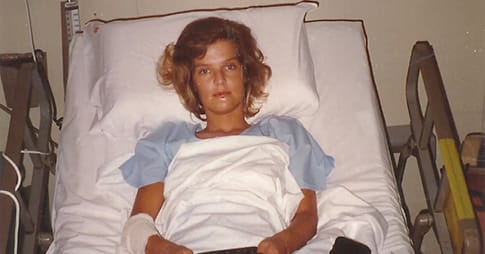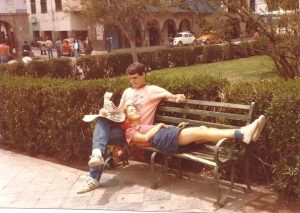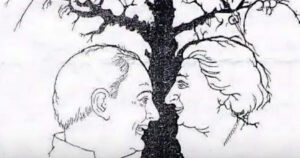Annette Herfkens – from wreckage to resilience

In 1992, Annette Herfkens was truly living her dream.
She had a flourishing career as a Wall Street trader, a vibrant love life, and the entire world seemed to be at her fingertips.
However, when she boarded a flight with her beloved partner, everything changed in an instant, becoming a nightmare.
Thirty-three years ago, Annette Herfkens, originally from the Netherlands, was caught up in what was meant to be the perfect romantic getaway.
Her long-time partner, William — the man she had cherished for 13 years — persuaded her to take a well-deserved break from their demanding careers.
William was leading the Vietnam branch of Internationale Nederlanden Bank, while Annette was a trader. After enduring six long months apart, working in various countries, they finally found time for one another.
This trip was intended to be their reunion — an opportunity to reconnect and rejuvenate. The itinerary? Begin in the vibrant Ho Chi Minh City, then travel to the idyllic coastal resort of Nha Trang for some sun, sand, and tranquility.
But along with 23 other passengers on Vietnam Airlines Flight 474, their adventure would take a tragic turn.
A gut feeling before takeoff
As someone who has always struggled with claustrophobia, Annette Herfkens was overwhelmed by a sense of fear when she boarded the Yakovlev Yak-40 on November 14th, 1992. This aging Soviet jet was meant to take her and her fiancé to the warm shores of Nha Trang.Her fiancé, affectionately known as “Pasje,” attempted to calm her anxiety with a little fib: the journey would only last 20 minutes.

Wikipedia Commons
However, after 40 minutes had gone by and we were still in the air, panic began to take hold.
“Pasje glanced at me, his face filled with fear. ‘Naturally, a lousy little toy plane falls like this!’ I replied, taking his hand. ‘It’s merely an air pocket — no need to fret.’ Yet, he had every reason to be concerned. We plummeted once more. A scream pierced the air. It turned completely dark. Moments later, we hit the ground,” Herfkens recounted to the New York Post.
Waking up from a nightmare
As she regained her senses, the sounds of the Vietnamese jungle surrounded her.
A stranger’s body lay across her. Close by, van der Pas was still strapped in his seat — smiling, yet lifeless. Gone.
“That’s when you have to choose between fight or flight,” she remarked. “I definitely opted for flight,” Annette shared with The Guardian.
Her recollections of escaping the wreckage are hazy. “It must have been agonizing to get out of there,” she reflected. “So I must have crawled out of the plane and lowered myself down. Then I must have crawled another 30 yards.”
She was severely injured — with a shattered hip, broken leg, collapsed lung, and a bone sticking out from her jaw. But she was alive. And she was not alone.
Enveloped by the deceased
In the initial moments following the crash, Annette was not the sole survivor.
She could hear moans and wails. A Vietnamese businessman even offered her some clothes after her skirt ripped. However, gradually, the voices dwindled into quietness.
Before long, she found herself encircled solely by the dead.
To endure, she practiced yoga breathing techniques to cope with her lung injury — “mindfulness before it became a popular term,” she referred to it.

Annette Herfkens with Willem van der Pas in Peru, 1983. / annetteherfkens.com
She gathered rainwater by utilizing insulation from the wings of the plane, which caused her elbows to tear so severely that they eventually needed skin grafts.
“Every two hours, I would take a sip,” she recounted. “And then—I would pat myself on the back. That also helps you to survive.”
The world believed she was lost.
Back home, families were mourning. Her obituary was published in the newspaper. Her boss sent a letter of condolence. However, her colleague and dear friend, Jaime Lupa, refused to lose hope.
“When I made a promise to Annette’s father before I departed: ‘I will bring your daughter back alive,’ he became enraged,” Lupa shared. “‘You are a fool,’ he shouted. ‘Get real!’
On the seventh day, Herfkens sensed herself fading away. But on the eighth day, a miracle occurred.
A Vietnamese policeman and his team showed up — carrying only body bags.
They did not anticipate finding anyone alive.
After being transported down the mountain on a makeshift stretcher, Herfkens made her way back home. In December, she attended her fiancé’s funeral — arriving in a wheelchair. By New Year’s, she was able to walk again. By February 1993, she had returned to her banking position.
A new life after tragedy
However, sorrow remained. Frustration simmered. Her trauma was still present.
Years later, she wed Jaime Lupa — the friend who had vowed to bring her back — and they welcomed two children, Joosje and Max. Although the couple eventually divorced, she built a new life while still cherishing the jungle that almost took her life.
“If you embrace what’s absent, then you can appreciate what’s present,” she expressed. “I came to terms with the fact that I wasn’t with my fiancé on the beach… Once I accepted that, I recognized what was there – and it was this stunning jungle.”
Her philosophy became the foundation of her book Turbulence: A True Story of Survival.
“You gain wisdom from experiencing setbacks.”
Later on, Annette became a motivational speaker, believing that it wasn’t merely chance that rescued her — it was her instincts.
“As the youngest child, I was surrounded by love, yet I often found myself alone. Without parents guiding me on what to do or how to feel, I honed my instincts,” she shared.
She even speculates that undiagnosed ADHD contributed to her being “creative and charismatic” as a child. “Had I been given Ritalin back then, I might not have cultivated the survival skills I needed in the jungle,” she remarked.
When her son Max received an autism diagnosis, she adopted a similar survival attitude: “You need to grieve what’s missing,” she explained. “But concentrate on what is present. That’s what I did with my son.”
She became part of inclusive communities, reached out to parents from diverse backgrounds, and even took Max on practice visits to the police station—just to be prepared.
“In our group, there were many black autistic boys, and it was crucial for the mothers to teach them that when the police arrived, they needed to keep their hands visible,” she shared.
Still counting the days
Every year, Herfkens commemorates the eight-day anniversary of the crash. She drinks water. She treats herself to a gift.
“I enjoy pampering myself,” she says with a grin. “I’m quite good at it.”
Her trauma has never completely faded. She steers clear of sitting behind other passengers on flights. Vietnamese cuisine can still evoke flashbacks. Yet, she has never ceased to survive.
Even Hollywood producers struggled to grasp her narrative—wanting to shift the focus more onto themselves.
“I truly believe that my survival is due to the fact that I moved past my own limitations,” she shared. “Once you transcend your own small self, your instincts kick in, and then you can accomplish great things.”
Even now, the jungle—where she lost everything—remains her refuge.
“It has been my ‘safe haven’ ever since,” she clarified.
For Annette Herfkens, survival is not just a fleeting moment. It represents a mindset. A lifestyle. A lesson learned through loss — and in discovering the light filtering through the foliage.
